How caves are formed
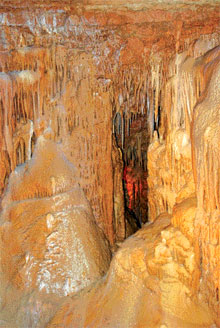
Fracture cave |
Intriguing, mysterious, eerie, call them whatever you like, caves
have fascinated man from time immemorial. Caves are found throughout the
world and there are many caves even in Sri Lanka. To most of you a cave
may be just another geological formation that is similar to a tunnel.
But you will be amazed to learn that there are a number of different
types of caves in existence around the world and some of them are
considered to be unique in their features. So, let us go on a trek into
the world of caves to discover some fascinating facts about these
natural cavities in the land or sea.
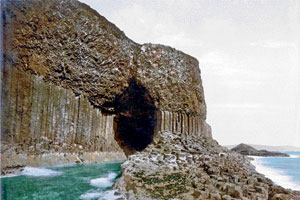
Sea cave |

Glacier cave |
| |
A cave or cavern as it is also called is generally an underground
space or a cavity which is usually in total darkness and large enough
for a human to enter. Even small spaces like rock shelters, and grottos
are also considered as caves.
There may be millions of caves all over the world but not all of them
have been explored and documented. Most of the caves that have been
discovered and documented by those who explore caves are the caves in
countries where caving has been popular. Some of these countries are
Italy, France, the United Kingdom, Australia and the United States of
America.
Throughout history, primitive people have made use of caves for
shelter, burial, or as religious sites. Since items placed in caves are
protected from the climate and scavenging animals, this means caves are
an archaeological treasure house for learning about these people. Cave
paintings are of particular interest.
Do you know how caves are formed? They are formed by various geologic
processes. These may involve a combination of chemical processes,
erosion from water, tectonic forces, micro-organisms, pressure,
atmospheric influence, and even digging. Most caves are formed in
limestone by dissolution. They are formed over thousands of years by
water.
What happens is that rain mixes with carbon dioxide in the air and
forms a weak solution of carbonic acid. This ‘acid rain’ dissolves
limestone and forms caves over time. Some limestone caves like Carlsbad
Caverns are formed by rainwater mixing with hydrogen sulfide in the
earth.
This creates a weak solution of sulfuric acid which also dissolves
limestone.
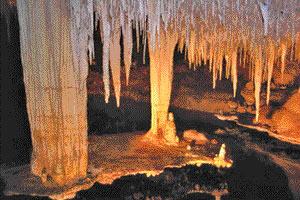
Limestone cave |
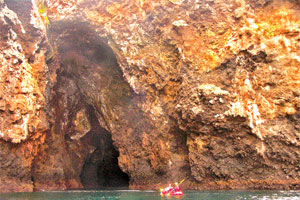
Sea cave |

Talus cave |
In either case, other minerals are dissolved by the acidic water
which then drips inside the cave. Over many years this dripping deposits
the minerals in the form of stalactites and stalagmites and other
beautiful formations.
As we mentioned earlier, there are various types of caves formed as a
result of any one of the above mentioned processes. There are solutional
caves, primary caves, sea caves or littoral caves, corrasional or
erosional caves, glacier caves, fracture caves, talus caves, and
anchhaline caves to name a few. From among these caves, the most
frequently occurring caves are the ones which are called solutional
caves or limetone caves. These caves are formed in soluble rock such as
limestone. They can also form in other types of rock which includes
dolomite, chalk, salt, marble and gypsum. What appears as cracks
initially expand into caves or cave systems over the many years as a
result of geological changes.
The largest and most abundant solutional caves are located in
limestone and are often adorned with calcium carbonate formations
produced through slow precipitation.
According to researchers, portions of a solutional cave that are
below the water table or the local level of the groundwater generally
get flooded. Lechuguilla Cave in New Mexico and nearby Carlsbad Cavern
are now believed to be examples of another type of solutional cave.

Glacier cave |
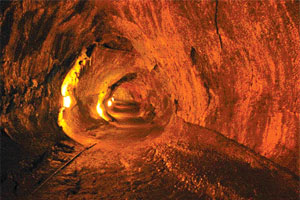
Lava tube |
Caves which are formed at the same time as the surrounding rock are
sometimes called primary caves. The most common primary caves are Lava
tubes formed through volcanic activity. When the lava flows downhill the
surface cools and solidifies. Sometimes when the hotter lava continues
to flow under that crust, most of the liquid lava beneath the crust
flows out, leaving a hollow tub-like formation which is called a cavity.
These type of caves can be found in Hawaii and the Canary Islands,
and also many other places. Lava caves, include but are not limited to
lava tubes. Other caves formed through volcanic activity include rift
caves, lava mold caves, open vertical volcanic conduits, and
inflationary caves.
There are many caves which form along coasts around the world and
they are called sea caves. Littoral caves are formed by wave action in
areas where the sea cliffs are weak. Often these weaknesses are faults,
but they may also be dykes or bedding-plane contacts.
Sea caves are generally around five to fifty metres (16 to 160 ft) in
length. There are some sea caves that exceed 300 metres (980 ft).
Corrasional or erosional caves are those that form entirely by
erosion that takes place due to the rocks and sediments carried by
flowing streams.
These can form in any type of rock, including hard rocks such as
granite. Generally there must be some zone of weakness to guide the
water, such as a fault or joint. A subtype of the erosional cave is the
wind or aeolian cave, carved by wind-born sediments.
Many caves formed initially by solutional processes often undergo a
subsequent phase of erosional or vadose enlargement where active streams
or rivers pass through them.
Then there are glacier caves - those which form in ice and under
glaciers as a result of melting ice. They are also influenced by the
very slow flow of the ice, which tends to close the caves again. (These
are sometimes called ice caves, though this term is properly reserved
for caves that contain year-round ice formations).
Fracture caves are formed when layers of more soluble minerals, such
as gypsum, dissolve out from between layers of less soluble rock.
These rocks fracture and collapse in blocks of stone. The openings
between rocks that have fallen down into a pile, often at the bases of
cliffs are called talus caves.
Anchihaline caves occur in many parts of the world, and often contain
highly specialised and endemic faunas. They are caves, usually coastal,
containing a mixture of freshwater and saline water (sea water).
More on caves next week.
*******************
FAST FACTS
* A large number of explored caves are found in Europe, Asia, North
America and Oceania. However, they are not as abundant in Africa,
Antarctica and South America .
* China contains half of the world’s limestone (more than 1,000,000
square mi) but it has very few documented caves,
* The science of exploration and study of all aspects of caves and
the environment which surrounds the caves is known as Speleology.
* Exploring a cave for recreation or science may be called caving,
potholing, or in Canada and the United States, spelunking
* Kazumura Cave near Hilo is a remarkably long and deep lava tube
cave. It is 65.6 km long (40.8 mi).
* Great Cave of Niah, in Malaysia, which contains evidence of human
habitation dating back 40,000 years.
* The Diepkloof Rock Shelter in South Africa contains evidence of
human habitation and use of symbols dating back 60,000 years.
* A lava tube of significant academic value has been found in the
Geomunoreum Lava Tube System, a UNESCO World Heritage site in Jeju. The
cave, is over 100 m long, 5 m wide and 1.8 m high.
While lava cave products including the lave flow traces on the wall
are well preserved, it also features picturesque characteristics of lime
caves such as stalactites and stalagmites.
********************
RECORD HOLDERS
* The cave system with the greatest total length of surveyed passage
is Mammoth Cave (Kentucky, USA) at 628 kilometres (390 mi) in length.
This record is unlikely to be surpassed in the near future, as the next
most extensive known cave is Jewel Cave near Custer, South Dakota, at
242 kilometres (150 mi)
* The longest surveyed underwater cave is Sistema Sac Actun in
Yucatin, Mexico at 215 km (134 mi). The record has been exchanged
several times with Sistema Ox Bel Ha, currently at 182 kilometres (113
mi).
* The deepest known cave (measured from its highest entrance to its
lowest point) is Voronya Cave (Abkhazia), with a depth of 2,191 metres
(7,188 ft). This was the first cave to be explored to a depth of more
than two kilometres (1.2 mi). The first cave to be descended below one
kilometre (0.62 mi) was the famous Gouffre Berger in France.) The
Illyuzia-Mezhonnogo-Snezhnaya cave in Abkhazia, (1,753 metres or 5,751
feet) and the Lamprechtsofen Vogelschacht Weg Schacht in Austria (1,632
metres or 5,354 feet) are the current second- and third-deepest caves.
The deepest cave record has changed several times in recent years.
* The deepest vertical shaft in a cave is 603 metres (1,978 ft) in
Vrtoglavica Cave in Slovenia. The second deepest is Patkov Gu ít at 553
metres (1,814 ft) in the Velebit mountain, Croatia.
* The largest cave room ever discovered is the Sarawak Chamber, in
the Gunung Mulu National Park (Miri, Sarawak, Borneo, Malaysia), a
sloping, boulder strewn chamber with an area of approximately 700 by 400
metres (2,297 by 1,312 ft) and a height of 80 metres (260 ft). The
nearby Clearwater Cave System is believed to be the world’s largest cave
by volume, with a calculated volume of 30,347,540 m3.
* The largest passage ever discovered is in the Son Doong Cave in
Phong Nha-Ke Bang National Park in Quang Binh Province, Vietnam.
Explored by joint Vietnamese-British cave scientists of the British Cave
Research Association, it is 4.6 km (2.9 mi) in length, 80 m (260 ft)
high and wide over most of its length, but over 140 m (460 ft) high and
wide for part of its length.
World’s five longest surveyed caves
* Mammoth Cave, Kentucky, USA
* Jewel Cave, South Dakota, USA
* Optymistychna Cave, Ukraine
* Wind Cave, South Dakota, USA
* Sistema Sac Actun, Mexico.
Facts and pix: Internet |

